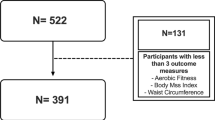Abstract
Objective: To determine physical activity levels (PAL) in children aged between 10 and 13 y.
Design: Cross‐sectional study of physical activity levels on school days, with and without physical education (PE) lessons and at weekend. Data were collected using self‐reported activity diaries.
Setting: The children were recruited from a middle school in Oxford. Basal metabolic rate (BMR) and anthropometry were measured in the school.
Subjects: Thirty‐eight children (12 boys and 26 girls), aged 10–13 y, returned completed activity diaries. PAL values were calculated by applying physical activity ratios (PAR) to the time spent on each activity. BMR and anthropometry were measured within 20 d of activity diary completion.
Results: The mean ±s.d. (range) PAL values for all children were 1.52±0.08 (1.34–1.71), 1.50±0.05 (1.44–1.57) for boys and 1.53±0.10 (1.34–1.71) for girls. The lowest PAL value (1.48±0.13, mean ±s.d.) was observed in girls on school days without PE lessons. The lowest PAL value in boys (1.46±0.13, mean ±s.d.) was observed at the weekend. PE lessons made a significant difference to the PAL values for boys (1.58±0.09) and girls (1.60±0.12). A wide range of PAL values (1.20–1.87) was recorded in these children. The total energy expenditure for the boys was slightly lower than the estimated average requirements (EAR) predicted by the Department of Health (8.71±0.96 MJ compared with 8.86 MJ/d) for this age group. The girls had a higher average energy expenditure than the predicted EAR (8.47±1.00 MJ/d compared with 7.885).
Conclusions: The children in this study may be classified as light to moderately active with PAL values ranging from 1.20 to 1.87. The promotion of physical activity in childhood will have beneficial effects for the child and their future wellbeing. Programmes aimed at preventing obesity in children should encourage physical activity as well as promoting appropriate dietary changes.
Sponsorship: Néstle Foundation, Lausanne, Switzerland.
This is a preview of subscription content, access via your institution
Access options
Subscribe to this journal
Receive 12 print issues and online access
$259.00 per year
only $21.58 per issue
Buy this article
- Purchase on Springer Link
- Instant access to full article PDF
Prices may be subject to local taxes which are calculated during checkout
Similar content being viewed by others
Author information
Authors and Affiliations
Contributions
Guarantor: CJK Henry
Contributions: CJK Henry, study originator and director, interpretation of data and preparation of the manuscript; JD Webster‐Gandy, analysis and interpretation of data and preparation of the manuscript; M Elia, Co PhD supervisor of S Dyer; S Dyer, data collection.
Rights and permissions
About this article
Cite this article
Henry, C., Webster‐Gandy, J. & Elia, M. Physical activity levels in a sample of Oxford school children aged 10–13 years. Eur J Clin Nutr 53, 840–843 (1999). https://doi.org/10.1038/sj.ejcn.1600859
Received:
Revised:
Accepted:
Published:
Issue Date:
DOI: https://doi.org/10.1038/sj.ejcn.1600859
Keywords
This article is cited by
-
Daily energy expenditure, activity patterns, and energy costs of the various activities in French 12–16-y-old adolescents in free living conditions
European Journal of Clinical Nutrition (2002)



